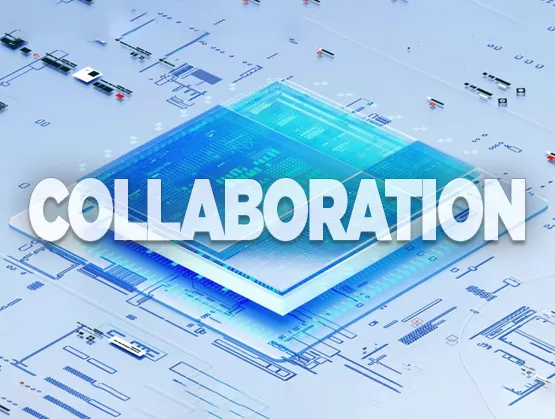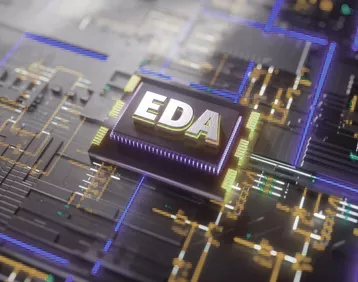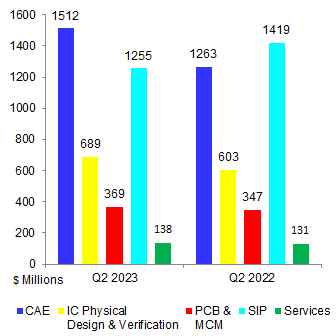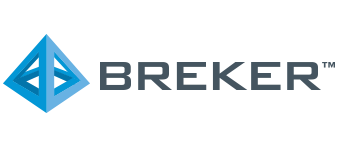
Bridging the Frontier Bob Smith, Executive Director
Bob Smith is Executive Director of the ESD Alliance responsible for its management and operations. Previously, Bob was senior vice president of Marketing and Business Development at Uniquify, responsible for brand development, positioning, strategy and business development activities. Bob began his … More » Griffin Securities’ Jay Vleeschhouwer and Wall Street’s Current View of EDA IndustryNovember 15th, 2023 by Bob Smith, Executive Director
 Note: Last week, my SEMI Q&A blog post with Charles Shi, principal and senior analyst at Needham & Company, was republished here. This week, I turn to Jay Vleeschhouwer, managing director of software research at Griffin Securities, for his perspective from another Q&A blog post that appeared recently on SEMI. Jay Vleeschhouwer is a knowledgeable EDA industry follower in his role as a financial analyst and has tracked the EDA industry for more than 25 years.I spoke with him recently for his insights on the state of electronic design automation (EDA), the topic of his presentation at the 2023 Design Automation Conference (DAC). Smith: After many years of single-digit growth, the EDA industry has accelerated to growth rates in the double-digits. What are the key drivers behind this trend? Vleeschhouwer: The industry has accelerated and growth has moved into double digits for the last number of years. Our forecast for 2023 is that we’ll have another double-digit growth year to about $13 billion from more than $11.5 billion in total industry revenue last year. EDA product and engineering requirements are driven by multiple catalysts. The EDA industry has been around for four decades and it’s always been used for automating design and enhancing productivity, for doing tasks that cannot be done manually owing to the complexity of semiconductor design and implementation.
This is apparent from the industry data. In the late 90s, industry growth was narrowly based among a few product categories. As implementation requirements began growing in the early 2000s, customers had to employ a larger set of increasingly integrated tools. This led to broad growth across multiple tool categories, a different situation from the beginnings of the EDA industry. This trend of multiple tools and integration is important to the momentum and financial health of the industry and is driven by the complex technical requirements of leading-edge semiconductor design. One of the most important structural and competitive changes that began roughly two decades ago was when Cadence and Synopsys responded to customer requirements by broadening their offerings and becoming increasingly alike in their product portfolios. This was evident by Synopsys’ acquisition of Avant! and many of the Cadence acquisitions. Another example of this structural change is Magma Design Automation in the early 2000s. It had the right place and route solution for the right problem at the right time, until Cadence and Synopsys became increasingly competitive. Ultimately, Synopsys acquired Magma. The cumulative result of the massive technical integrations across toolsets coupled with numerous acquisitions by Ansys, Cadence, Synopsys and Siemens EDA (the Big Four) is consolidation. In the EDA industry, the Big Four now account for about 90% of industry revenue, far more concentrated than in other software industries that we cover. This concentration has financial implications in terms of pricing and profitability.
The EDA companies’ margins, specifically Cadence’s and Synopsys’, have materially increased to the mid 30% or better and are sustainable, with positive cash flow. In turn, that further increases the market values for EDA stocks. Looking back over the last decade, the period when we began recommending EDA stocks, the increase in EDA market caps has been approximately tenfold or more, a remarkable increase. Similarly, the price-to-earnings ratios have gone up, as have the ratios of enterprise value to revenue. Those metrics have improved and are now stable characteristics of those two companies. Smith: Do you expect this double-digit growth and profitability will continue without the big fluctuations we see in the semiconductor market that goes through historical boom and bust periods? Vleeschhouwer: The best we can foresee for this year, maybe into next year, is that EDA has at least another year of double-digit growth. We expect to see mid-teens growth in terms of revenue from both Cadence and Synopsys in 2023. The big variable in the total industry results is Siemens EDA, formerly Mentor Graphics. Its business has grown considerably – by about half since the acquisition of Mentor by Siemens in 2017. All else being equal, it has the most variable revenue because Mentor operated on a mostly upfront license model. Compared to Cadence and Synopsys, Siemens EDA has proportionately the smallest amount of subscription revenue, which is generally a more stable model that grows more smoothly, with less variability. At Siemens EDA, the variability is tied to the timing and magnitude of contract renewals for its physical verification and printed circuit board design (PCB) businesses, less so for the emulation and prototyping hardware business.
When looking at the Siemens EDA numbers, we consider the numbers on a two- or three-year comparative basis by comparing the most recent quarter with the same quarter two years ago or three years ago to average out the growth. That tends to smooth out the variability. Clearly there’s underlying growth. Siemens EDA business has grown by about half since 2016, the final year that Mentor reported and the company continues to dominate in physical verification and PCB. From the EDA data, it’s clear that physical verification has been a large category and growing over the years, as has PCB. In terms of your original question on industry variability, that’s part of it. Outside of the core EDA software business is an inherent variability of the IP (semiconductor intellectual property) business and hardware-assisted-verification business, even during a great environment when there are no concerns about the economy. Variability in IP revenue exists since the accounting rules require recognition of much of the licensing revenue as up-front. Hardware is typically based on non-recurring revenue and is also a growing category. No one would have imagined 20 years ago that hardware or IP, not necessarily financially attractive at that time, would surpass a billion dollars each in annual revenue. IP is now a $2 billion category. That’s a long-term growth trend line, around which there is going to be inherent variability because revenue recognition is tied to the consumption of the product. Smith: I read the announcement that Synopsys is teaming up with Intel to supply its foundry operations with IP, which would have been unimaginable 15 or 20 years ago. Vleeschhouwer: You bring up a good point, because Intel has been Synopsys’ largest customer for the past two decades. Intel has accounted for more than 10% of Synopsys’ revenue every year since 2004.
Synopsys’ fiscal 2017 and fiscal 2018, included two back-to-back years of $100 million increases in revenue from Intel, likely attributable to increased hardware sales. In fiscal 2022, based on disclosures in Synopsys’ annual report, Intel’s revenue to Synopsys set a record, increasing by approximately $150 million. Hardware has become a much larger category in the semiconductor design industry and customers including Intel now consume hardware in substantial quantities as designs are becoming increasingly more complex. Smith: The definition of the democratization of chip design is open-source software solutions for tools and IP. RISC-V is a good example. Our industry has an ongoing talent shortage. The result of open source could be more people learning how to do chip design. Some critics view it as a threat. Do you see where this would have measurable impact on what’s going on in the EDA software business? Vleeschhouwer: Democratization is a word that has also been applied in the other side of Engineering Software, specifically with respect to simulation in the industrial and manufacturing markets like aerospace and automotive. Historically, simulation has been largely used by a small, highly trained and specialized set of users. When we look at non-EDA simulation over the last 20 years, the growth of that industry started to accelerate and the profile changed. Clearly, simulation has grown substantially in its core markets and beyond. Does that translate into a vast army of users? Not necessarily. In the mechanical computer automated design (CAD) market, the number of simulation users remains a fraction of the number of CAD users, which is well over a million.
The parallel in the EDA world is integration to solve multiple variables. Even though EDA has been growing in double digits and effectively doubled in a relatively short period of time, the number of users has not doubled. Using a simple metric, the average revenue per employee and the average revenue per customer have gone up because revenue has been increasing faster than the number of individual users. More licenses are being used per user and pricing has gone up. EDA companies have more pricing power than they had 20 years ago. I tend not to be an adherent to the democratization notion of EDA. It would be more relevant in the non-EDA side of Engineering Software because of the larger number of customers. In EDA, we’re talking about a relatively small number of companies in terms of revenue, maybe a few hundred. In the manufacturing and industrial world, tens of thousands of customers span the multiple end-markets. If anything, democratization would more likely be in that part of Engineering Software, given the greater scale of the customer base than EDA, which continues to be a concentrated specialization. Smith: You talk about Engineering Software starting to converge with EDA. Do you think this will continue and, if so, how will it change the industry in terms of growth and profitability? Do you expect to see more consolidation and or more collaborations across the industry? Vleeschhouwer: You’re referring to the theme of the panel the first day of Design Automation Conference with Ansys, Cadence, Dassault, PTC and Siemens, a theme that didn’t suddenly occur. It’s been something in the air for years and only recently technological, customer or market-driven reasons make it more compelling. It is beginning to be manifested in company portfolio strategies. Two companies that best exemplify this theme are Siemens and Ansys. They combine elements of non-EDA and EDA in their portfolios and the partnership between Cadence and Dassault is an acknowledgement. The two companies were obviously aware of each other before the formal relationship and had discussions going back to the early 2000s. Ansys has multiple relationships across the industry. It’s fascinating to see its relationships with PTC, Synopsys and Autodesk are all simulation-centric. There are two arms races in technology. One is software development and that has been manifested in the AI arms race. The second is a silicon arms race, which is related to the first in part, but it’s been ongoing for several years because of what’s going on with automotive, consumer electronics, communications and data centers. Ansys has put together an ecosystem that demonstrates that the convergence between EDA and the rest of Engineering Software is part of an overall arms race in technology. Smith: Do you see EDA encroaching into the broader areas of Engineering Software? Vleeschhouwer: Perhaps implicit in your question is what Cadence is doing with its Intelligent System Design or ISD strategy and its ambitions in the automotive and aerospace markets. At Cadence, that’s been manifested with acquisitions in some new, not purely EDA areas such as physics with acquisitions of computational fluid companies such as Numeca and PointWise. So, yes, it is evident that some point tools are being offered for non-EDA applications. If I interpreted your question correctly, Cadence is clearly strategically focusing on moving into adjacent areas to EDA. It has to start somewhere with point tools and have a more unified data platform. Cadence certainly exemplifies the move beyond EDA. By the same token, Siemens exemplified that strategy by accumulating properties across the EDA and Engineering Software spaces. Needham & Company’s Charles Shi Remains Upbeat on Electronic System Design EcosystemNovember 2nd, 2023 by Bob Smith, Executive Director
Note: My Q&A blog post below with Charles Shi, Principal and Senior Analyst at Needham & Company, LLC., appeared in September on the SEMI website. I found Charles to be upbeat about the EDA, IP and services business. So much so, that I’m reposting the SEMI post here for your enjoyment. Charles Shi, Principal and Senior Analyst at Needham & Company, LLC., remains upbeat about the EDA, IP and services business, or what SEMI refers to as the electronic system design (ESD) ecosystem. I recently spoke with Shi about his talk Looking Forward to the New Chip Cycle during the opening of the 2023 Design Automation Conference, collocated in July with SEMICON West in San Francisco. Following are excerpts from our conversation. Smith: You talked about how electronic design automation (EDA) has historically been cycle-proof, whereas the semiconductor industry goes through “boom and bust” cycles. Why the difference? Why doesn’t EDA also go through similar cycles? Shi: It’s because EDA revenue comes from the R&D expense of the semiconductor industry. Imagine a fabless semiconductor company going into a downturn. The company will cut back wafer orders to foundries to get inventory and cost of goods sold (COGS) under control. It will reduce marketing dollars, lay off salespeople, and limit employee travel to cut back on selling, general and administrative (SG&A) expenses. On the EVE of the RISC-V Summit North AmericaOctober 22nd, 2023 by Bob Smith, Executive Director
The ESD Alliance hosted an engrossing evening in the early days of RISC-V featuring two of its authors. At the time, RISC-V was a fledgling concept and it’s doubtful anyone there that night would have believed how quickly it was adopted across the semiconductor industry. On the eve of the RISC-V Summit North America, it’s a great time to look back on its beginning and how it became a semiconductor industry phenomenon. For answers, I turned to Calista Redmond, CEO of RISC-V International, and Tiffany Sparks, its Director of Marketing. Smith: RISC-V as an open standard is starting to take root in the mainstream semiconductor industry and it’s not just DYIers or hobbyists. What’s changed? Is this the wave of the future? Redmond: Due to RISC-V being an open standard, the playing field is level, enabling companies of all sizes to engage in custom computing without the traditional challenges associated with licensing, royalties, and design limitations in proprietary models. Combined with the open foundational architecture of RISC-V, this reduced barrier to entry is a significant factor why RISC-V is taking root, and why it is here to stay. More than 3,900 RISC-V members across 70 countries contribute and collaborate to define RISC-V open specifications as well as convene and govern related technical, industry, domain, and special interest groups. While our roots were born in academia, industry stakeholders were invested from the beginning. As new workloads demanded a more flexible and open design approach, investment in RISC-V began to soar. RISC-V is an open, global standard. This is a critical distinction in that we freeze and ratify the essential specifications. As an open standard, anyone may leverage RISC-V as a building block in their open or proprietary solutions and services. This created a new model for companies of all sizes to engage in custom compute. RISC-V is a transformative force shaping the future of hardware and software design and computing. As for the future, I would say it is here to stay. Electronic System Design Industry Posts $4 Billion in Revenue in Q2 2023, ESD Alliance ReportsOctober 18th, 2023 by Bob Smith, Executive Director
The Electronic System Design (ESD) industry continues to prove its value to the entire electronics supply chain as we report a revenue increase of 5.3% to $3,962.7 million in the second quarter of 2023. That’s up from $3,763.6 million in the second quarter of 2022, according to the latest Electronic Design Market Data (EDMD) report. The four-quarter moving average that compares the most recent four quarters to the prior four rose 9.5%. Likewise, companies tracked in the EDMD report employed 59,160 people globally in Q2 2023, an 11.8% jump over the Q2 2022 headcount of 52,918 and up 2.5% compared to Q1 2023. “Total license and maintenance revenue, which includes all design tools, was strong at 16.1% overall with double-digit growth in all regions except Japan,” remarks Wally Rhines, Executive Sponsor of the SEMI EDMD report. He added that growth in total electronic design automation (EDA) revenue in Q2 23 was limited by weak semiconductor IP (SIP) revenue. This week’s quarterly EDMD report includes revenue information broken down by category and geographic areas. For example, Computer-Aided Engineering (CAE) revenue jumped 19.7% to $1,512.4 million as the four-quarter CAE moving average increased 17.6%. IC Physical Design and Verification revenue rose 14.2% to $689 million and the four-quarter moving average increased 17.2%. Printed Circuit Board and Multi-Chip Module (PCB and MCM) revenue increased 6.3% to $369 million. The four-quarter moving average for PCB and MCM rose 11.7%. Services revenue increased 5.2% to $137.5 million as the four-quarter Services moving average rose 12.3%. Only Semiconductor Intellectual Property (SIP) revenue decreased –– 11.6% to $1,255 million with the four-quarter SIP moving average falling 1.6%. Two regions reported declines in Q2 2023 –– the Americas and Japan. The Americas, the largest reporting region by revenue, landed $1,627.9 million of electronic system design products and services in Q2 2023, an 0.6% decline, though the four-quarter moving average for the Americas rose 7.5%. Japan’s procurement of electronic system design products and services decreased 4.3% to $241.6 million as the four-quarter moving average for Japan fell 0.3%. Atomera on Boosting Semiconductor Performance With Quantum-Engineered MaterialsOctober 12th, 2023 by Bob Smith, Executive Director
 Atomera, a semiconductor materials and technology licensing company, is the newest member of the ESD Alliance. In welcoming Atomera to our membership, I spoke with Atomera CEO Scott Bibaud to learn more about its atomic-level technology that enhances transistors to improve performance in electronic products. We also discussed quantum-engineered materials and their impact on chip performance, recruiting and industry trends. Atomera, a semiconductor materials and technology licensing company, is the newest member of the ESD Alliance. In welcoming Atomera to our membership, I spoke with Atomera CEO Scott Bibaud to learn more about its atomic-level technology that enhances transistors to improve performance in electronic products. We also discussed quantum-engineered materials and their impact on chip performance, recruiting and industry trends.Smith: The Atomera website highlights quantum-engineered materials. Can you elaborate on what a quantum-engineered material is and why it is different than other materials? Bibaud: We consider a material to be quantum-engineered when it is first designed using quantum-mechanical ab initio simulations that identify the required material properties. This is in contrast to most materials in use in the semiconductor industry, which are either known in nature or developed empirically. Atomera’s MST® (Mears Silicon Technology™) is an example of a bottoms-up quantum-engineered material as are others such as ReRAM/MRAM memory elements, quantum wells/dots, and high-K metal gate (HKMG) metal stacks. Drive Innovation and Networking Event Featuring Drako Motors Dragon Electric SupercarSeptember 21st, 2023 by Bob Smith, Executive Director
Anyone who knows Dean Drako recognizes his innovative spirit and entrepreneurial mindset. He aimed those talents to EDA in the late 1980s when he started Design Acceleration (now Cadence) and then founded IC Manage in 2002 before moving on to security with Barracuda Networks and Eagle Eye. Dean remains firmly in charge today as CEO of both IC Manage and Eagle Eye. Not content with juggling the responsibilities of those two entrepreneurial endeavors, Dean and Shiv Sikand (also executive vice president at IC Manage) founded Drako Motors, an American luxury sports car manufacturer. Drako Motors’ much sought-after, limited-production electric supercars deliver high performance with maximum control and safety on road and track. Now’s your chance to see the Drako Dragon, a powerful 2,000-horsepower quad motor hyper-luxury electric SUV with a top speed of 206 mph, launched late last year. I take great pleasure in inviting you to an interactive networking event featuring Drako Dragon, on display during a “Beer and Brats BBQ” networking reception. The event, sponsored by the Electronic System Design (ESD) Alliance, a SEMI Strategic Technology Community, will be held Wednesday, October 18, at SEMI Headquarters in Milpitas, Calif., in conjunction with a meeting being held by SEMI’s Global Automotive Advisory Council (GAAC). GAAC’s mission is to bring the automotive electronics supply chain together to foster connection and collaboration. ESD Alliance September News: Kaufman Recipient, SEMI Server Certification ProtocolSeptember 14th, 2023 by Bob Smith, Executive Director
Early September has been a time of announcements from the ESD Alliance, a SEMI Technology Community. First, we congratulate Dr. Lawrence Pileggi, Coraluppi Head and Tanoto Professor of Electrical and Computer Engineering at Carnegie Mellon University, as the 2023 Phil Kaufman Award for distinguished contributions to Electronic System Design (ESD). The annual award, given by the ESD Alliance and IEEE’s Council on Electronic Design Automation (CEDA), will be presented at the Phil Kaufman Award ceremony and dinner in Q1 2024. Details to follow.
With piracy costing the software industry an estimated billions of dollars annually, the protocol will help prevent unauthorized access to licensed software products by assigning a unique identifier to each customer license server to assure software access can only be granted by authorized servers. To learn more, join us for a webinar about the SEMI License Server Certification Protocol and how it can be deployed It will be held Wednesday, September 27, from 10-11:30am PDT and registration is free of charge. About Dr. Lawrence Pileggi Dr. Pileggi is this year’s Phil Kaufman Award recipient for his pioneering contributions to circuit simulation and optimization that enable the industry to address the challenge of interconnect delay dominated designs. He is also recognized for his innovations in Electrical and Computer Engineering (ECE) education. Prior to his current role at Carnegie Mellon University, Dr. Pileggi held positions at Westinghouse Research and Development and the University of Texas at Austin. He has consulted for various semiconductor and EDA companies and co-founded Fabbrix Inc., Extreme DA, and Pearl Street Technologies. His research interests include various aspects of digital and analog integrated circuit design and simulation, optimization, and modeling of electric power systems. Dr. Pileggi has received numerous awards, including the ACM/IEEE A. Richard Newton Technical Impact Award in Electronic Design Automation in 2011 and the 2015 Semiconductor Industry Association (SIA) University Researcher Award. He co-authored Electronic Circuit and System Simulation Methods, McGraw-Hill, 1995 and IC Interconnect Analysis, Kluwer, 2002, has published over 400 conference and journal papers, and holds 40 U.S. patents. He is a fellow of the IEEE. Dr. Pileggi received his Bachelor of Science degree in Electrical Engineering and a Master of Science degree in Electrical Engineering from the University of Pittsburgh and his Ph.D. from Carnegie Mellon University. About the Phil Kaufman Award The Phil Kaufman Award honors individuals who have had a demonstrable impact on the field of electronic system design through technology innovations, education/mentoring, or business or industry leadership. The award was established as a tribute to Phil Kaufman, the late industry pioneer who turned innovative technologies into commercial businesses that have benefited electronic designers. The 2022 recipient was Dr. Giovanni de Micheli, Professor and Director of the Institute of Electrical Engineering and of the Integrated Systems Centre at EPF Lausanne, Switzerland. About The ESD Alliance The ESD Alliance, a SEMI Technology Community, represents members in the electronic system and semiconductor design ecosystem as the marketing advocate and address economic issues affecting the entire industry. We act as the central voice to communicate and promote the value of the semiconductor design ecosystem as a vital component of the global electronics industry. Companies that are already SEMI members, can become members of the ESD Alliance by submitting a short application with no extra fee. Companies not SEMI members can apply at the same time to join the ESD Alliance. Again, no extra fee is associated with being a part of the ESD Alliance. Contact me at Bob Smith at bsmith@semi.org with questions. Follow SEMI ESD Alliance ESD Alliance Bridging the Frontier blog Twitter: @ESDAlliance ESD Alliance Hosts SEMI License Server Certification Protocol WebinarAugust 16th, 2023 by Paul Cohen
We’re hosting a webinar on the new SEMI License Server Certification Protocol and invite you to attend. The event will be held Wednesday, September 27, from 10-11:30am PDT. Registration is free of charge. The webinar will address the challenges anyone responsible for a company’s software licensing practices and infrastructure faces. If that’s you, you will learn how use of the protocol will strengthen your license management system against unauthorized license usage (piracy). Read the rest of ESD Alliance Hosts SEMI License Server Certification Protocol Webinar It Will Take a Village to Solve MultiphysicsAugust 3rd, 2023 by Bob Smith, Executive Director
Note: SEMI published in early July a post I wrote from a memorable discussion with John Lee, general manager and vice president of Ansys and a member of the ESD Alliance Governing Council. It’s reprinted below in its entirety.  John Lee, general manager and vice president of Ansys and a member of the ESD Alliance Governing Council, is on a quest to promote industry collaboration to solve many of the multiphysics challenges. When we talked recently, he reinforced his advocacy of open extensible platforms as a workable model for the industry. Ansys is a member of the Electronic System Design Alliance, a SEMI Technology Community. Smith: It’s been over a year since we talked about 3D IC and bespoke silicon. Are you still seeing them as major trends? Are they changing, accelerating, slowing down or are they here to stay? Lee: The forecast for 3D IC continues to accelerate. In fact, we expect to see a 3X increase in the number of 3D IC design starts this year over last. It started initially in areas like high-performance compute with AMD and Intel pioneering it. We now see many other markets outside of AI/ML, CPU, GPU and mobile applications. Even the more traditional manufacturers are doing 3D IC designs. From a foundry standpoint, TSMC has been talking about CoWoS for 10 years. We see the largest number of 2.5D and 3D IC tape-outs going through TSMC, but now Samsung and Intel are starting programs that will be a big service to the industry. 3D IC is here to stay and brings challenges that need to be solved. Shared Vision Unifying Factor for Business Success Says Maheen Hamid of Breker Verification SystemsJuly 27th, 2023 by Bob Smith, Executive Director
Note: My Q&A discussion with Maheen Hamid of Breker Verification Systems below appeared earlier this week on Semiwiki.
Maheen Hamid, a member of the ESD Alliance (a SEMI Technology Community) Governing Council and a member of SEMI’s North America Advisory Board, is an astute business executive. Together with her husband Adnan Hamid, they founded Breker Verification Systems, a company developing test synthesis solutions. She serves today as COO and CFO. We recently talked about her journey into the tech industry, how she’s able to leverage her MBA and her thoughts on leadership. We finished our conversation discussing the industry trends she is seeing and how Breker is reacting to those trends. Smith: What’s on your mind these days? Hamid: Any executive is always concerned with growing the business while optimizing investment opportunities. The tactics are dynamic with changing trends, but the strategic ambition is static. A long-term high-profile customer who has been familiar with the evolution of Breker recently said that he couldn’t imagine taping out a chip without using Breker solutions. If I had to pick any one thing that keeps me up at night, that is: How do I get all my customers to say exactly this? Introducing innovative approaches for novel capabilities is challenging in a mature market entrenched with legacy methodologies. We observe a growing convergence with unmet needs with test synthesis solutions across various verticals and design processes. Due to the initiative supported by Accellera since 2015, Portable Stimulus has become a desired solution space, especially with developing needs in generative AI applications, RISC-V, and leading-edge applications requiring increased compute power. Some of those applications are in healthcare such as genomic sequencing and cancer treatment, aerospace and various simulations in research labs. Breker is helping push the boundaries of verification technologies for complex chips. In line with our customer-centric, forward-looking positioning, I am focused on bringing agility to how we respond to the diverse demands of our users. |
|
|
|||||
|
|
|||||
|
|||||


 The inexorable scope and scale of complexity coupled with the need for multivariable optimization within semiconductor and electronic systems design creates a growing interdependency among multiple tool categories needed for design flows and to effectuate designs.
The inexorable scope and scale of complexity coupled with the need for multivariable optimization within semiconductor and electronic systems design creates a growing interdependency among multiple tool categories needed for design flows and to effectuate designs. Not only has EDA industry revenue accelerated, an outgrowth of recent semiconductor R&D acceleration, EDA companies have also reported a massive structural improvement in their profitability, which is reflected in their operating margins. In the past, they were below those of the counterpart companies in Engineering Software or technical software companies such as Dassault, PTC and Autodesk that have higher margin structure on average.
Not only has EDA industry revenue accelerated, an outgrowth of recent semiconductor R&D acceleration, EDA companies have also reported a massive structural improvement in their profitability, which is reflected in their operating margins. In the past, they were below those of the counterpart companies in Engineering Software or technical software companies such as Dassault, PTC and Autodesk that have higher margin structure on average. This has been characteristic of the Mentor/Siemens model for years and will be a considerable variable in what the final industry revenues turn out to be. In the first quarter of this year, for example, it looked like Siemens EDA revenues were up approximately 9% versus a mid-20% decline last year. On the other hand, in the June 2023 quarter, it didn’t give a precise number, but we have derived an approximate 15% decline year-over-year versus a 20% increase the year before. In absolute terms, it looks like the second calendar quarter was nearly the same sequentially as the first calendar quarter. Basically, flat sequentially, but considerably variable on a year-over-year basis.
This has been characteristic of the Mentor/Siemens model for years and will be a considerable variable in what the final industry revenues turn out to be. In the first quarter of this year, for example, it looked like Siemens EDA revenues were up approximately 9% versus a mid-20% decline last year. On the other hand, in the June 2023 quarter, it didn’t give a precise number, but we have derived an approximate 15% decline year-over-year versus a 20% increase the year before. In absolute terms, it looks like the second calendar quarter was nearly the same sequentially as the first calendar quarter. Basically, flat sequentially, but considerably variable on a year-over-year basis. Intel is by far the largest commercial spender on EDA software and a large consumer of hardware. The largest part of that is going to Synopsys, though it has increased its spending with Cadence.
Intel is by far the largest commercial spender on EDA software and a large consumer of hardware. The largest part of that is going to Synopsys, though it has increased its spending with Cadence. Is that democratization? No. It’s just an expansion of a market due to compelling technical and business reasons. One of the reasons is the exogenous effect of massively cheaper compute power while another is the endogenous effect of increasingly powerful, higher capacity, easier to use software that is increasingly integrated across multiple physics.
Is that democratization? No. It’s just an expansion of a market due to compelling technical and business reasons. One of the reasons is the exogenous effect of massively cheaper compute power while another is the endogenous effect of increasingly powerful, higher capacity, easier to use software that is increasingly integrated across multiple physics.












